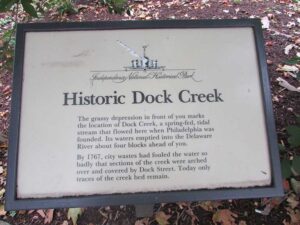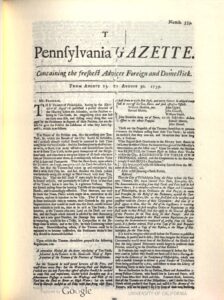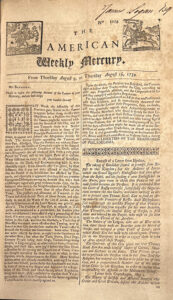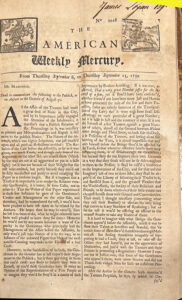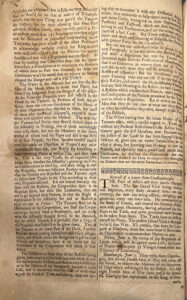
Conservation, public health, and concern about the environment are routine features of public life, not only in our own era, but also in history at nearly any time or place (Neuzil, 1996). A classic example is the 1739 controversy over water pollution in Dock Creek, a small stream that once flowed through downtown Philadelphia.
The Dock Creek controversy was America’s first recorded environmental controversy, although there were probably others beforehand. It’s also interesting because it involved two feuding newspaper editors — Benjamin Franklin of the Pennsylvania Gazette and Andrew Bradford of the American Weekly Mercury – who took different sides on the issue. And it is also an example of the way the media record can be a source of information about little-known environmental and public health controversies (Kovarik, 1993).
Bradford was the first printer in Pennsylvania and among the first in the US. His Philadelphia operation opened in 1713 and he published the first edition of the weekly Mercury on Dec. 22, 1719 (Willard, 1938). The newspaper, he said, “shall contain an Impartial account of Transactions, in the Several States of Europe, America, etc.”
Franklin had become editor of the Gazette when he purchased Bradford’s failing competitor called the Pennsylvania Gazette. He published his first edition on October 2, I729 (Clark, 1989). “The Author of a Gazette,” he wrote, ought to have “a Great Easiness and Command of Writing and Relating Things cleanly and intelligibly, and in few Words; he should be able to speak of War both by Land and Sea; be well acquainted with Geography, with the History of the Time, with the several Interests of Princes and States, the Secrets of Courts, and the Manners and Customs of all Nations.”
A great publishing rivalry
The two publishers were a generation apart – Bradford was born in 1686 in York, England, and Franklin in 1706 in Boston. Like Franklin, Bradford was a reformer and was often critical of government. Bradford also published the “Busy-Body” essays, written by Franklin and Joseph Breintnall, before Franklin purchased the Gazette.
Franklin did not think much of Bradford. He was “poorly qualified for their business… and was very illiterate,” Franklin said in his 1771 autobiography. The Mercury was “a paltry thing, wretchedly manag’d, (and in) no way entertaining.” The feeling was mutual, and over time, the two became great rivals.
Franklin was a shrewd and competitive businessman. Around 1736, he got Bradford fired for doing a poor job printing an important Pennsylvania House document. As Franklin said, it was printed in “a coarse, blundering manner.” Franklin took it on himself to reprint it “elegantly and correctly,” and then sent a copy to every member of the House. “They were sensible of the difference: it strengthened the hands of our friends … and they voted us their printers for the year ensuing.”
Bradford also lost his job as postmaster to Franklin. While serving in the position from 1728 to 1737, Bradford apparently served some of his own interests, and meanwhile was unkind enough to forbid his riders from carrying Franklin’s Gazette, although the riders would often carry Franklin’s mail privately. Franklin did not retaliate when, in 1737, Bradford was removed from the office and Franklin was appointed as his replacement.
And so the 1739 controversy over Dock Creek took place against a backdrop of rivalry, and at a time when Bradford’s fortunes were declining and Franklin’s were on the rise. Although his experiments with electricity and his involvement in revolutionary diplomacy were still ahead of him, his civic leadership at the city and state levels had become widely admired in the 1730s. He created a civic group (the Junto) that established Philadelphia’s first lending library in 1730, the first volunteer firefighting company in 1736, and would go on to help found the first Pennsylvania university in 1743 and the first state hospital in 1751.
Franklin thought about Dock Creek pollution as one of the “small matters” that ought to concern civic leaders. Laws about dumping trash were on the books in Philadelphia and other cities in the American colonies. As early as 1657, for example, New Amsterdam (New York) had a law making each resident responsible for his own trash (Melosi, 1981). In Boston, between 1692 and 1708, trades that were considered a nuisance, like tanneries and slaughterhouses, were removed from the city limits. In 1711, the legislative body in colonial Boston placed fines on those who used “the old Dock” to dispose of dirt or trash. (Christopher, 2020)
At the time of the Dock Creek controversy, Philadelphia was the second largest British city in the North American colonies, with a population around 13,000. Boston was first, with 16,400 and New York was third, with 11,000 (Lydon, 1967). The city was dominated by Quakers, a Protestant denomination, and William Penn’s heirs, who controlled the colony and its politics as proprietors. As a result, reforms that should have taken place did not, and this may have been a particular problem with water pollution in Dock Creek.
Usually, household garbage, horse manure and sewage accumulated in the streets until it was swept away by the next rainstorm. In small communities this was not an enormous problem, but as towns became the focus of increasing commercial activity in the 18th and 19th centuries, the urban environment became a focus of greater concern. In a growing town like Philadelphia, pollution was an important issue; in a great city like London, it was a public health disaster.
The petition and the protest
The Philadelphia water pollution conflict of 1739 might be counted as America’s first recorded environmental controversy. It began on May 15 of that year when a group of Philadelphia citizens presented a petition to the Pennsylvania Assembly to stop water pollution in the city’s commercial district. Leather tanneries, slaughterhouses and breweries were dumping their wastes into a small tributary of the Delaware River called Dock Creek that ran through the city. Franklin probably signed it, but even if he did not, it is clear from his reporting in the Gazette that he was in favor of cleaning up Dock Creek. The petition asked the Assembly to declare the tanneries a nuisance and asked that they be “removed in such Time as might be tho’t reasonable.”
Describing the problem, Franklin noted that “many offensive and unwholesome smells do arise from the Tan-Yards, much to the great Annoyance of the Neighborhood.” In an article in his newspaper, the Pennsylvania Gazette, Franklin said the Tanners “…choaked the Dock — which was formerly navigable as high as Third Street — with the Tan, Horns, &c.:” (Franklin, 1739).
Franklin was no disinterested protester, said historian A. Michael McMahon. “His residences and business properties in the area involved him personally, and as an affluent citizen desiring to protect his investments… Perhaps more than his fellow citizens, [he] saw the problems as inherent in unchecked growth…” (McMahon, 1992; Double, 2013).
Franklin and the petitioners noted that the smells affected property values and that the waste choking the creek limited its use in fighting fires. They also said if the creek were not polluted it would be “of great use” for delivering supplies to the city. The Dock had been created “for publick Service.” Franklin’s argument was for “public rights,” and the restraints on the liberty of the tanners would be “but a trifle” compared to the “damage done to others, and the city, by remaining where they are.” Franklin also noted a compromise position: “If the tanners could be so regulated to become inoffensive, the Petitioners declar’d that they should be therewith satisfied.”
The tanners responded with their own petition, proposing to wash the pavement once a day, build a fence around the tan yards, and release the waste into Dock Creek only at high tide. They also found a champion in Franklin’s rival, Andrew Bradford, whose American Mercury defended the liberty and property rights of the tanners.
On August 27, 1739, a committee of the Assembly heard the petition. Sometime before the hearing, perhaps that day, the tanners staged a parade through town, carrying their grievances to the people and insisting on their rights. The Assembly heard both sides, but what happened next is unclear. Apparently, Bradford’s Mercury carried an article falsely stating that the environmentalists’ petition had been rejected. Its headline was: “A Daring Attempt on the Liberties of the Tradesmen of Philadelphia.”
Franklin’s temper boiled at this misinformation, and he printed the full text of the Assembly resolution, which supported the environmentalists. The resolution declared that the water pollution was indeed a nuisance and that regulations should be drawn up. “It is hard to imagine what could induce the tanners to publish a relation [account] so partial and so false,” Franklin wrote. “In Prudence they ought not to have triumphed before the victory.” It wasn’t a question of the liberties of the tradesmen but rather “only a modest Attempt to deliver a great Number of Tradesmen from being poisoned by a few, and restore to them the Liberty of Breathing freely in their own Houses.”
One reason why reform proposals ran into so much opposition was that the slaughterhouses, tanneries, and breweries were owned by leading Quaker citizens of Philadelphia. Six of the ten tanneries were the property of William Hudson, a Philadelphia resident from a family of tanners in York, England. Hudson was a mayor, alderman and judge – as well as a businessman – and was also the owner of Hudson’s Square, a city park that is now the site of the Liberty Bell exhibit. The list of prominent polluters would be incomplete without the most important brewers in Philadelphia — Anthony Morris and his son, Quaker leaders from a family of brewers in Stepney, England. They also served as mayors in 1704 and 1738.
These business leaders would have worked together, since the supply chains for beer, meat and leather are interconnected. Brewers sell leftover grain “slops” to feed cattle, which are kept until slaughtered for meat. Afterward, the cattle hides are used to make leather. All of these activities create a tremendous amount of waste water.
When the tanneries were subsequently cleaned up is unclear, but they were not moved, to Franklin’s chagrin. The 1739 environmental victory, in the end, was merely symbolic, although it had many of the elements that would emerge in later environmental controversies: battling editors, inaccurate articles, petitions, demonstrations, legislative hearings and ambiguous victories.
Dock Creek and yellow fever, 1740s
Two years later, an epidemic of yellow fever that killed 500 Philadelphia residents was blamed on the pollution from Dock Creek. Philadelphia’s leading physician, Franklin’s friend Thomas Bond, said in a 1741 article that the creek was linked to malaria and other diseases and that not so much “bark” (quinine) would be needed if the waterway would be filled in (McMahon, 1992).
The epidemic led to a new round of concern about Dock Creek, and by 1747, Franklin was appointed to a committee to consider what to do about restoring it. The committee recommended an extensive sewer system, and a rebuilt dock that could accommodate various sizes of boats. However, the proposal was defeated due to its high costs. Over the years, a few private attempts to deal with garbage removal and build sewers could not keep pace with the expanding tanneries and distilleries along the creek and nearby river. Philadelphia’s environment deteriorated, and more pressing political priorities in London took Franklin’s attention.
In 1763, however, Franklin returned briefly to Philadelphia and was involved in a new effort to finance and organize street cleaning and storm water drainage. Twenty five years after the original Dock Creek petition, a new proposal to clean and maintain the creek was considered, but a committee found the area totally polluted and “in great measure useless.” Soon, workers began to cover Dock Creek.
Around the same time, Franklin served on other committees that took a comprehensive approach to municipal planning, street lighting, waste disposal, police work and firefighting. He could not have been fully satisfied with the outcome of his work, according to McMahon. Although the 1760s ordinances looked like progress, “for those who fought to save the Dock and to reclaim the center of the city for residences and small-scale crafts and retail shops, those acts capitulated to manufacturing interests and uncontrolled growth.” (McMahon, 1992).
Franklin saw Dock Creek as a valuable part of the city because it allowed small boats hauling fuel and building materials from nearby farms to reach the commercial district. “Franklin envisioned a benign balance between city and country, with each supplying the economic and social needs of the other,” said McMahon. He disliked the domination of manufacturing interests in the city. Like Thomas Jefferson and other agrarians of the era, he strongly believed that the country instilled moral virtues and that the city tended to drain them. At one point Franklin wrote that he was glad that many ages would pass before Americans would be forced into the cities as they had been in England. (Franklin, 1751).
Franklin’s will
In the political turmoil of the next three decades, the 1760s ordinances were ignored. When Franklin arrived in Paris in 1767, beginning an ambassadorship that would culminate in French support for the American revolution, one of the first things he noticed was that Paris had a system of sewers that was “much more modern” than that of London, as well as a filtration system for drinking water (Fay, 1939).
After the revolution, when he returned to Philadelphia, he worried about the continued epidemics of yellow fever in his home city, which he attributed to the poor quality of water from old wells and contaminated springs. The water, Franklin wrote, would “gradually grow worse” and “in time be unfit for use, as I find has happened in all old cities.”
In his final year, 1789, Franklin wrote a codicil to his will leaving money for Philadelphia to build a conduit to bring clean water from Wissahickon Creek into the town. The project was not carried out as he intended, but a devastating yellow fever epidemic, which killed a quarter of Philadelphia’s population in the mid-1790s, led to the formation of the Watering Committee of Philadelphia to build the water line. However, to save money, a shorter fresh water line to the Schuylkill River was built in 1801.
Building the shorter water line was short sighted. Hundreds of industries crowded the Schuylkill River and polluted the water intakes by the mid- to late-19th century. Repeated complaints about the factories and their impact on drinking water were made, but to no avail. The dye works, the oil refineries, the mills and the breweries continued to pollute the river, and their destruction of it amounted to a “wanton outrage on common decency,” in the view of one engineer.
But the public outrage was insufficient to overcome the resistance of manufacturers to paying for a sewer line, and in 1867, the Pennsylvania legislature rejected a proposal to regulate water pollution. “Makeshift engineering” and corruption dominated the city’s water and sewer development later in the 19th century, and prominent engineers bitterly complained that the “vile waters” of the Schuylkill flowed directly into Philadelphia’s homes (McMahon, 1988).
(Draft paper with bibliography: Kovarik.DockCreek)
 Philadelphia printers
Philadelphia printers
- Benjamin Franklin
- The printer as entrepreneur (Library co. of Philadelphia)
- Autobiography of Benjamin Franklin
- Andrew Bradford
- Samuel Keimer
Tanners, brewers and other figures
- William Hudson (tanner)
- Hudson’s Square archeology project.
- William Hudson, Mayor
- Benjamin Rush (doctor)
- Thomas Bond (doctor)
Historical markers
- Historic Dock Creek marker
- Benjamin Rush house site marker
- Thomas Paine “Common Sense” historical marker
- A backyard in the capital city
Water pollution in the colonial era
- How tanning worked
- The tannery – an indispensable industry
- Leatherworkers in colonial Virginia (Colonial Williamsburg report, 1990)
- Review of Melvin Melosi’s book Sanitary City. Sanitation advocates up to 1880 worked under the notion that miasmas — filth and bad odors — caused disease and sickness. Generally, waste disposal was an individual responsibility.
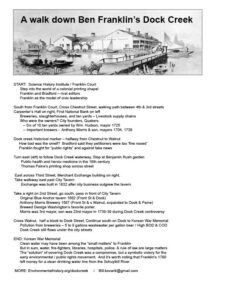
SEJ Conference April 3-7, Philadelphia PA, Tour # 10.

